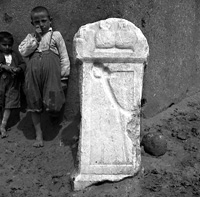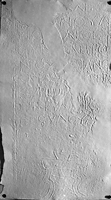 MAMA XI 230 (Kinna)
MAMA XI 230 (Kinna) 
Funerary stele for Kyrion and Kyrilla
- Type of monument:
- Funerary stele.
- Location:
- Kulu (Kinna): in a lane.
- Description:
- White limestone stele with arched pediment, broken above and below; back side rough. In the pediment, male and female busts in relief, each with right arm bent across the chest and resting in arm-sling of toga and pallia respectively. Inscription on shaft, substantially defaced by later re-use as threshold of a door. Below the inscription, incised depiction of an animal-legged tripod table with a one-handled skyphos resting on top. Plain pilasters to l. and r.
- Dimensions:
- Ht. 1.23+; W. 0.52 (upper moulding), 0.42 (shaft); Th. 0.35; letters 0.020-0.030.
- Record:
- Squeeze; AH notebook copy; photograph (1957/4=5718).
- Publication:
- None.
- Date:
- Fourth century AD.
[(e.g.) Πατρο]κ̣λῆς
κ̣α̣[ὶ Ἰα]νουά-
ριο[ς] κ̣αὶ οἱ
συνκ̣ληρο-
5νόμ̣οι ἀνέ-
σθησα[ν] π̣α̣τρὶ̣
Κυρίω⟨νι⟩ (?) κ[αὶ μη]-
τρὶ Κ⟨υρί⟩λλ̣ης,
Θεοῦ δούλ[ῃ].
Line 7: ΚΥΡΙΩΚ[- -].
Line 8: ΚΡΥΛΛ̣ΗΣ.
[Patro]kles and Ianuarius and their co-heirs set this up for their father Kyrio⟨n⟩(?) and their mother K⟨yri⟩lle, servant of God.





For the Roman name Ianuarius in inner Anatolia, see e.g. I.Ankara 8.51, 9.14, 126; Ramsay, Phrygia II 657, no. 603 (Akmoneia); MAMA X 75 (Altıntaş); MAMA XI 261, MAMA XI 273 (1957/83-4: Nevine [Bahçesaray]). The term συνκληρονόμος, ‘joint heir’, is extremely rare: cf. SEG 8, 91 (Beit Ras/Capitolias). For the spelling ἀνέσθησα[ν] (lines 5-6), see Brixhe 1987: 110-3 and cf. MAMA XI 228 (1957/8: ἀνέσθησεν). In line 7, I have tentatively assumed that the mason omitted the final syllable of the dative Κυρίω⟨νι⟩; the personal name Κυρίων is extremely common in inner Anatolia, while a personal name Κύριος (‘Lord’) is unattested and unlikely. In line 8, I assume that the sequence ΚΡΥΛΛ̣ΗΣ is a mason’s error for the common woman’s name Κ⟨υρί⟩λλ̣ης, with an irrational genitive termination (cf. MAMA XI 201 [1954/41: Kuyulusebil]; 234 (1957/12), 235 (1957/13): Yaraşlı). The description ‘servant of God’ (ἡ δούλη/ὁ δοῦλος τοῦ Θεοῦ) is highly characteristic of the Christian funerary epigraphy of Galatia, most particularly of Tavium and its territory (RECAM II 423-99). For the incised image below the inscription, see the commentary to MAMA XI 233 (1957/26: Yalınayak [Karacadağ]).